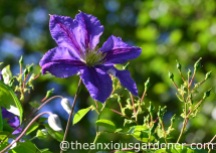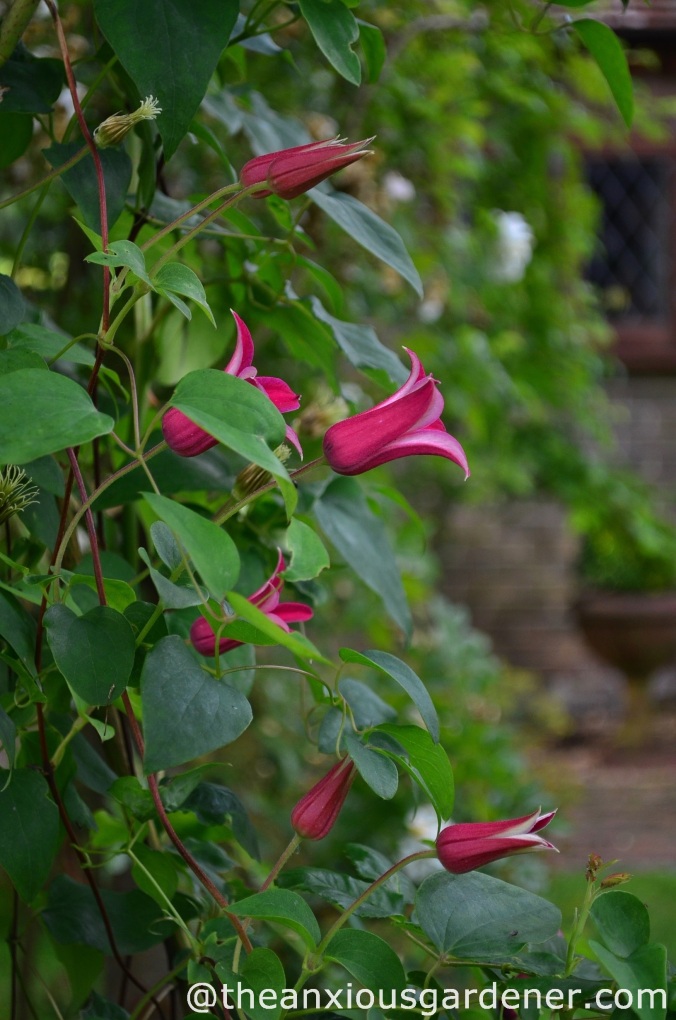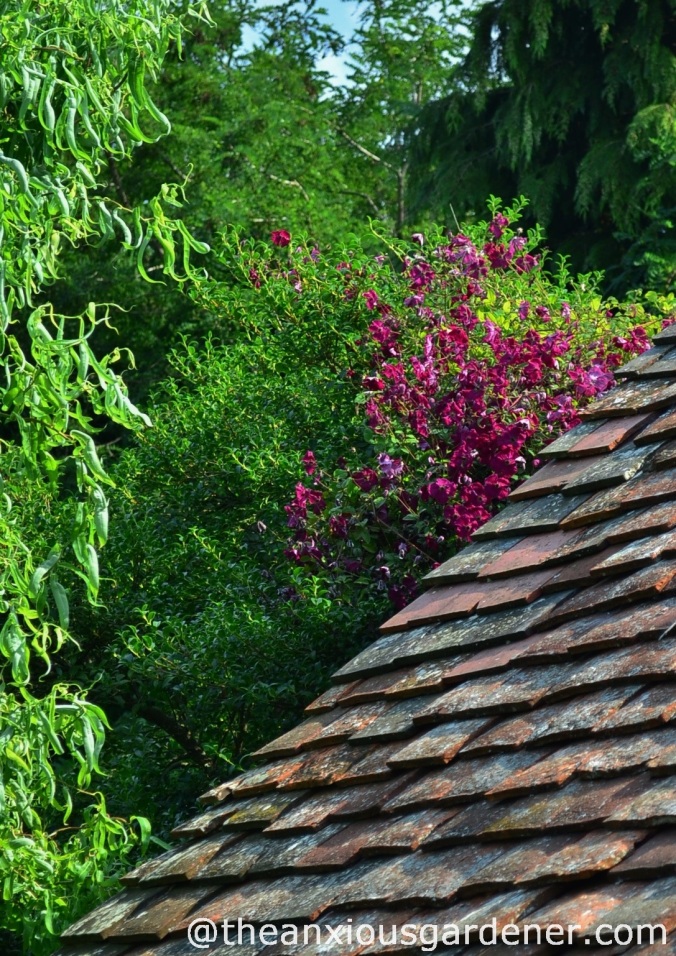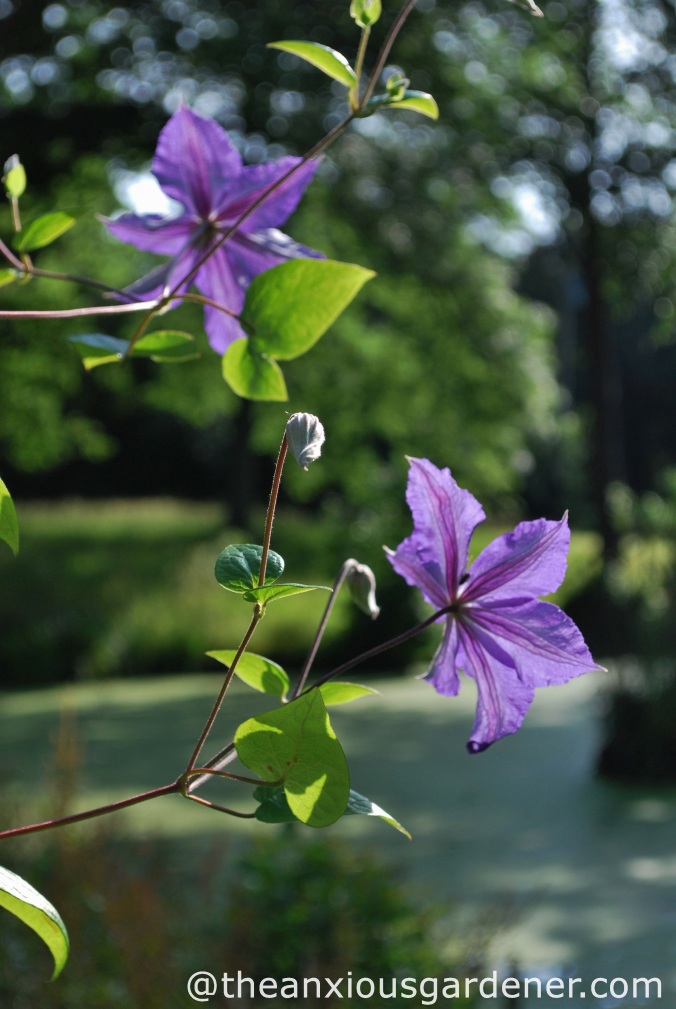I was a little disappointed that the Priory’s old and established garden only boasted one clematis. Over the last six years I have rectified that shortcoming by adding a further twenty or so and today there are almost two dozen clematis dotted about the grounds. Here are some of them.
The original Priory clematis is C. Jackmanii clambering three or four metres up into an ancient honeysuckle. It looks fine against the brick walls of the house with large, four or five petalled, purple flowers appearing in mid to late summer. (It is pruning group 3. I’ve added a note about clematis pruning groups at the end of this post, if you’re interested).
A couple of years ago, further along the same wall, and to grow up through winter jasmine, I planted C. ‘Etoile Violette’. This is a viticella hybrid – a vigorous group most of which flower for several months. (Also group 3). When I cut down the jasmine to ground level (the wall needed damp proofing), I moved ‘Etoile Violette‘ to the rose tunnel where it joined another half-dozen varieties.
The rose tunnel – extended recently and with many of the old, rotten posts replaced – is not yet completely smothered by roses. The rose smother rate isn’t helped by regular and enthusiastic pruning by visiting deer. They are particularly partial to young, knee-high roses which they can chomp at their leisure without having to crane their necks. Clematis add a little more interest to dwarfed roses – though these too are indiscriminately deer-nibbled.
This section of the tunnel, where I’m still training the scrambling Rosa ‘Sander’s White’ has Clematis ‘Wisley’ on the left with C. ‘Warsawska Nike’ on the right. (Both group 3).
I’m very fond of ‘Wisley’ – as I am of most plants that perform really well. The blue-ish petals look good against the white of the rose and it produces a huge amount of bud.
Also on the rose tunnel is C. ‘Westerplatte’ – a strong red, that slowly unfurls its large, velvety, pale-backed flower. (Group 2).
Here is a clematis which I introduced last year – C. Rooghhi. I like the pretty, nodding flowers – of which there would be plenty more if it weren’t for those sharp-toothed deer guests. (It’s Group 3).
Another new introduction is a rare (for me) pink – C. ‘Princess Diana’ (Group 3).
One of my favourites is C. ‘Broughton Bride’. I took this photo in my garden several years ago and left the plant behind when I moved away. I searched idly for a couple of years for one to add to the Priory. Eventually, I found ‘BB’ at my local garden centre, Paradise Park (which incidentally is neither a park nor paradise) reduced to £3. I grabbed it and rubbed my hands with glee. Dexterously tricky. That young plant has joined the rose tunnel. (Group 1).
This is a pretty thing – Clematis ‘Betty Corning’. Only in her second year, she is still young and relatively small. Betty is vigorous and will grow far higher and wider in the years to come. (Deer allowing). She’s a viticella so yep, pruning group 3.
I grow some clematis on walls. I trained C. koreana ‘Blue Eclipse’ along wires and it looked jolly nice … but then died. It was one of the first plants I put in at the Priory and I hadn’t realised how, during the winter, the soil it sat in would turn to soup. Poor thing. (It was group 1).
This is another viticella, C. ‘Black Prince’ growing up a wall and over the roof of an outbuilding. It too is a young plant and hopefully will put on more of a show in the years to come.
If you have no wall or roofs to cover, you might grow a clematis up through a tree or shrub. This very tall viticella, C. ‘Kermesina’ shoots out of the top of a 12ft Osmanthus burwoodii. Rather than a single spurt, I would have preferred a more spread-out effect. Perhaps in the future.
This was an unnamed gift but I’m fairly certain it is the beautiful ‘Miss Bateman’ – another favourite I left in my garden when I moved house. She is a group 2 – or at least would be were she still with us. She died.
I’m not sure why she decided to leave but I suspect repeated slug damage to young shoots. I’ll buy another ‘Miss Bateman’ but plant her elsewhere. She wasn’t tall enough for the amelanchier I put her under.
I quite like C. Niobe (group 2) but it’s also too short for this viburnum. Like Miss Bateman, Niobe reaches no taller than a metre or two. (Apparently it can grow to three metres but not in my experience).
And finally, a clematis that exceeded all my expectations is the happily named C. × triternata ‘Rubromarginata’ which I grow over a mahonia. (Group 3).
If the look alone weren’t enough it also has a superb, strong scent. Of marzipan. Quite a plant, I think. You can imagine my grief when it also died – again due to repeated slug attack. I’ve planted a replacement and during early season wet spells, guard it vigilantly against rasping molluscs.
oooOOOooo
Here’s that quick note on pruning. I think some people might be a little confused by pruning clematis but, so long as you know which group a variety belongs to, it is quite straight-forward. Make a note of the pruning group of any plant you buy – it’ll be on the label. Or look up the variety’s group online. Then all you need to do is this:
- Group 1 – flowers on previous year’s growth and needs hardly any pruning. Tidy up as necessary and reduce in size if it gets too big. If it does need hard cutting back, do so right after flowering.
- Group 2 – flowering stems produced from previous year growth. Cut back weak, damaged stems to a pair of strong buds in late winter. Tie in stems to form a framework in summer.
- Group 3 – flowers on current year’s growth. Cut stems back to a pair of strong buds in early spring, a foot or so above ground level.
And that’s it. If you want more detail on a particular variety or group, the internet or a decent gardening book will guide you. But don’t worry too much about pruning groups and certainly don’t be put off from planting these very useful and beautiful climbers. Clematis are tough plants and won’t mind too much if you make a pruning mistake. The worst that might happen is that you’ll miss a season’s flowers. So, for example, don’t hack a Clematis montana (Group 1) back in winter or early spring. As I’ve said, they flower on the previous season’s stems – which you will have just cut off.



























Pingback: We Made A Backyard, Half 2 | Earth 365
Hello!
I really enjoy reading your blog; finding it both informational and inspiring. I recently was nominated for a Liebster Award, which was pretty exciting for me being rather new to blogging. I would like to nominate your blog for the Liebster also. Please see my post at http://vanhatalosuomi.wordpress.com/ and following the steps if you accept. Thanks again for your great blogging contribution – keep it coming!
LikeLike
Thanks for that and I’m so pleased you like the blog. Dave.
LikeLiked by 1 person
Wow! There are some rather fantastic clematis there. I have 2 the names of which escape me at the moment. My problem is snails. They crawl all the way up the plant and eat the flowers. *sobs* Any ideas? Snails seem impervious to the methods I use to remove slugs. And whilst I can just about manage to snip slugs with scissors on my night-time patrols snails are another matter. They have a homing instinct so I can’t lob them over the garden fence. Any tips for getting a clematis to establish under a mature tree? I’d worry it would struggle to compete with the tree and I’d like one to scramble up through my crab apple. I’ve made a note of ‘Rubromarginata’. I love it. Lou
LikeLike
Hi Lou, the ‘old names escapes me’ syndrome is a devil isn’t it? But not something that I suffer from myself (cough). I don’t have the snails-ate-my-clematis-flowers-problem either. Yet. They certainly attack the young shoots but once the plants are up and away they seem fine. Sorry – not much help. (I just stomp on snails btw – I know about that fiendish homing instinct). As for planting them under established trees or shrubs – I dig a big hole, tip plenty of compost at the bottom, plant them 3 or 4 inches below the top of the root ball and then just ensure I water them very well through their first summer or two. As well as the clematis mentioned above, I’ve planted them under an elder, amongst ivy and under a berberis. They were all fine. Hope that helps. Dave
LikeLike
I have a serious case of Clematis-envyitus. Off to get a cream to rub in.
LikeLike
Ooh. Nasty. And contagious. D
LikeLike
Is there anything that slugs won’t eat! I’ve managed to instal one clematis (no idea what it is, beyond being a supermarket twig, must research) and it clambers up through a Morello cherry tree every year (purple and red, hmmm, could have thought that one through a bit better). The other, meant to scramble through a Viburnum x bodnantense, died. I’m still unsure whether it was too shaded, parched or just ripped out by passing thugs. Such is life. Still, a beautiful photo always inspires so maybe I’ll try a nice blue C. montana up the Cordyline australis …
LikeLike
Viburnum x bodnantense is a good choice for a clematis, I think Caro. The niobe above is growing up through one. I water clematis loads in their first year especially when planted under a shrub but yes, slugs are a real problem. I’m not sure about a montana over shrubs though. They’re so vigorous they might smother anything they swamp over! Let me know how you get on. Dave
LikeLike
One of my favourite activities at Sissinghurst in the summer is ‘twizzling’ clematis. We grow our clematis either on the walls or on hazel tripods and we use ‘twizzlers’ to tie them on. These are actually just paper ties with a very thin strip of metal running through the middle. I’m not sure how they became known as twizzlers but the name stuck and that’s what everyone here calls them. I usually train Perle d’Azur on the Powys Wall in the Rose Garden which is a very time-consuming job. It’s always a relief when it gets to the top! Helen
LikeLike
Hi Helen, yes I use twizzlers too (though they were known before now as just paper ties with a very thin strip of metal running through the middle). I’ve grown Perle d’Azur before but not at the Priory. I have room for plenty more so might have to get one of those too. D
LikeLike
I Love Clematis.
At one point, I had at least eight kinds scattered all over an acre of land, but I have since downsized, and have virtually no yard anymore. What l do have these days is in almost full shade, and not a hospitable clematis environment….
I once had Etoile Violette growing through rosa ‘New Dawn’, Jackmanii covering a deck railing, Sweet Autumn clematis all over the back fence, and an evergreen clematis that had tiny white blooms in early spring that smelled heavenly….
Yours are lovely……
LikeLike
That all sounds smashing. There are clematis that will tolerate shade. A Google search – clematis for full shade – should help you. But then it sounds like space is as much an issue for you. Sure you could squeeze one in though? D
LikeLike
Fantastic photos. They are a must have in any garden. I have lost clematis over the years, only to find them growing again after a couple of years. Do you think this could be Clematis wilt?
LikeLike
Hi Brian, yes it could be. (See my reply to Melfordcottagegarden below). I’ve had clematis reappear after being destroyed by slugs. I even had one throw up a shoot the year after being dug up! Obviously I’d inadvertently left enough root behind for it to do so. They’re pretty tough I think. Dave
LikeLike
Superb pictures that really capture the beauty of clematis.
LikeLike
Thank you, Philip.
LikeLike
Wow – what a wonderful C. × triternata ‘Rubromarginata’!
LikeLike
Isn’t it? I’m hoping that its replacement will be as successful.. Dave
LikeLike
I am not a Clematis lover but your lovely plants are making me re-think my strategy. I did not realise you could plant them over trees or shrubs that you wanted to live, I thought they were only used for covering garden rubbish you couldn’t move. My sister has subtly added some clematis to my garden so I will check out their groups and add clematis to my winter homework. Amelia
LikeLike
Glad you like them now, Amelia. And yes, I grow them up several trees and shrubs that would otherwise be a little dull during the summer. Dave
LikeLike
I loved this post as clematis are one of my favourite plants. I’m in Tasmania where it is early Summer and my clematis have just started really flowering.Have you had any die from clematis wilt? Occasionally one of mine does that but I’ve read it you plant them deeply, after you cut off the dead wilted stems, leaves etc above ground, they can reshoot. This seems to have worked mostly but the odd one still karks it permanently. Looking at your photos makes me want to plant more clematis though.
Love your blog and especially your photos!
LikeLike
Hi, that’s a good question. I was going to add a bit about wilt but the post was getting a little too long. I have had clematis wilt in my own garden (or so I thought) and possibly at the Priory too. I say possibly because when I did some research, I read that actually wilt is quite rare and often the plant packs up and wilts because of poor soil and/or planting conditions. As the Priory clematis that ‘wilted’ was certainly in poor soil (and up against an outbuilding), I wonder whether that was the reason? But yes, I always plant mine deep – three or four inches lower than the top of the rootball. This should ensure more stems and gives the plant a better chance of recovering. And please do plant more clematis – I certainly intend doing so. Dave p.s. Like the word karks.
LikeLike
Mice – far worse than slugs in my opinion. I’ve planted about a dozen new clematis in the past decade, and not a single one has survived. The slugs devour what the mice have left. I love clematis, so I’m bereft…
LikeLike
Bad news, Mr K. It is slugs (or at least mostly) for me – the slime trails are a sure giveaway. To lose a dozen must be very dispiriting. I felt bad enough at losing three or so. D
LikeLike
It did seem quite odd that a property of that size only had one Clematis. I’m glad you have rectified that!
LikeLike
I’m pretty sure there must have been more clematis once. The ‘gardening’ team who preceded me probably strimmed them into oblivion. (Note – I wasn’t very impressed by the ‘gardening’ team I inherited the job from). D
LikeLike
The only clematis that we both have is Princess Diana. And now you’ve tempted me with so many more. Shame I’m out of space!
LikeLike
Space isn’t something of which I’m short of, Janet. I would like to plant another twenty clematis. Princess Diana is lovely isn’t it? Despite a good-natured dislike to pink, I couldn’t resist her. D
LikeLike
I’ve always loved the viticellas. Delicate, late flowering and a doddle to prune. I’m after a blue so ‘Betty Corning’ definitely fits the bill.
LikeLike
Betty Corning is more of a Lavender Grey. Additionally on some plants there is sweet perfume a lemony orange-blossomy scent that does project away from the plant. However, not all plants are scented, oddly – I have several Betty Cornings in the garden, but probably less than half exhibit a scent.
Nevertheless, it is a great doer and one of my favourites.
LikeLike
Good choice, I think. My Mother in Law has one that covers most of a ten foot section of six foot high fence. Looks marvelous – which as why I put one in at the Priory. D
LikeLike
Interesting, Nick. I hadn’t noticed a scent on Betty – will have to get up close and personal next year.
LikeLike
Lovely to see these. Sadly I can’t grow clematis successfully in the Italian climate except for C. Amandii which just about survives the heat of summer. So yours are a very special treat for me. Thank you
LikeLike
Hi Christina, you’ve reminded me that there were two clematis at the Priory when I started – not one. The other was an amandii but though I kept it going for a couple of years it always looked horrible. It was just too wet and cold in the valley to thrive. It seemed a mercy, in the end, to cart it off to the bonfire. Dave
LikeLiked by 1 person
You have such gorgeous clematis specimens in your landscape…Love the photos.
LikeLike
Thanks Charlie. Room for plenty more. D
LikeLike